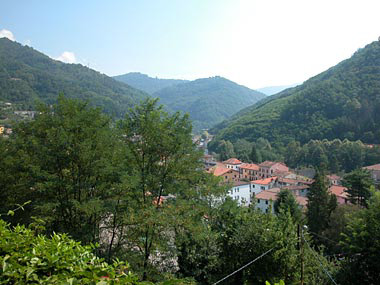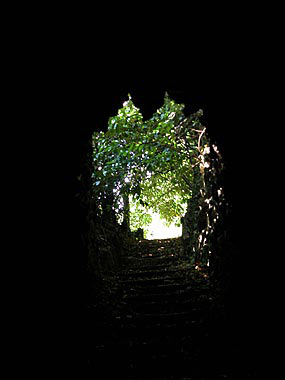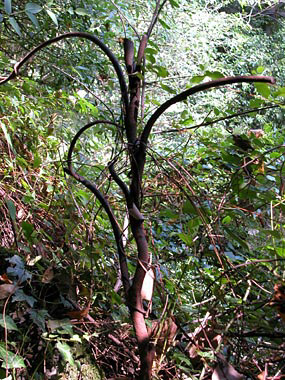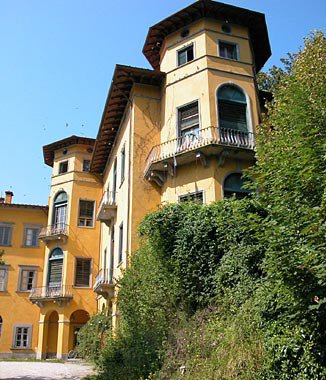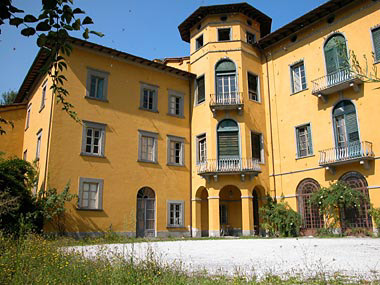Villa Ada in Bagni di Lucca

Information
District:
Mediavalle
Building dating:
16th century, re-done in 19th century
Garden dating:
19th century
District/Location:
The park of the villa is always open to the public.

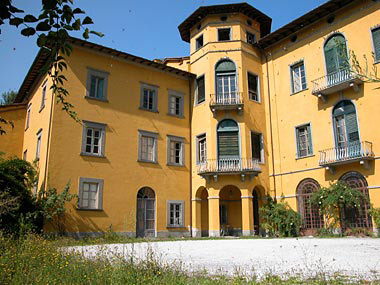
Villa Ada in Bagni di Lucca is the result of a 19th century intervention on late renaissance structures. It has an irregular plan as more buildings were added to its structure over the course of time. The two high, hexagonal towers, which give the villa its characteristic appearance, were added in the 1800's.
A wide portico opens at the base of the central hexagonal tower, while on the upper floors, there are balconies with arched window-doors. The windows, decorated with grey stone cornices, are arranged in regular intervals on the façade, which is ochre in colour. The entrance to the villa, with its great glass windows, the stairs and marble floors, is the most magnificent part of the building.
The garden, which has lots of ground, is of romantic taste. The long avenue which gives access to the villa, unwinds into a wood where particular garden furnishings were realised. In addition to the artificial grottos in calcareous stone, there still remains traces of the arbours i.e. architectural structures entirely composed of laurel plants, which formed a roof of branches and leaves over some stone chairs. The garden paths had interesting wrought iron railings, which reproduced shapes of entwined branches. Some pieces still remain in a zone of the lower part of the park which is accessed with difficulty. A terrace is accessed by way of the villa, which looks out onto a noteworthy panorama of the valley. From here, a footpath leads to a pergola which then continues onto a dark, artificial grotto on a route whose aim it was to offer the visitor the emotions given by different picturesque views.
A wide portico opens at the base of the central hexagonal tower, while on the upper floors, there are balconies with arched window-doors. The windows, decorated with grey stone cornices, are arranged in regular intervals on the façade, which is ochre in colour. The entrance to the villa, with its great glass windows, the stairs and marble floors, is the most magnificent part of the building.
The garden, which has lots of ground, is of romantic taste. The long avenue which gives access to the villa, unwinds into a wood where particular garden furnishings were realised. In addition to the artificial grottos in calcareous stone, there still remains traces of the arbours i.e. architectural structures entirely composed of laurel plants, which formed a roof of branches and leaves over some stone chairs. The garden paths had interesting wrought iron railings, which reproduced shapes of entwined branches. Some pieces still remain in a zone of the lower part of the park which is accessed with difficulty. A terrace is accessed by way of the villa, which looks out onto a noteworthy panorama of the valley. From here, a footpath leads to a pergola which then continues onto a dark, artificial grotto on a route whose aim it was to offer the visitor the emotions given by different picturesque views.
Via Evangelina Whipple, 55022 Bagni di Lucca LU
The building is mentioned in the cadastral survey in the archives of the Bagni di Lucca local district council in 1558. In 1622, the property appeared to belong to the same owners, the inheritors of Cesare de Nobili, along with a bigger edifice bordering the first one. In 1710, as seen on an incision by Terreni, the two buildings were joined together to form one palace.
In 1870, the villa passes to MacBean, the British consule in Livorno. He is responsible for the restructuring of the north wing of the building, adding on the two hexagonal towers, and the layout of the garden. The park was originally bigger in size, but the realisation of the communal swimming baths reduced its extension.
In 1870, the villa passes to MacBean, the British consule in Livorno. He is responsible for the restructuring of the north wing of the building, adding on the two hexagonal towers, and the layout of the garden. The park was originally bigger in size, but the realisation of the communal swimming baths reduced its extension.
- CHERUBINI B., I Bagni di Lucca, Maria Pacini Fazzi, Lucca,1998
- BURLAMACCHI M., Le antiche case del Bagno alla Villa, Firenze, 1979
- Archivio Soprintendenza B.A.A.A.S. delle province di Pisa, Lucca, Massa Carrara, Livorno (schedatore: Tolomei)
Scopri altre attrazioni vicino a Villa Ada in Bagni di Lucca
See allYou may also like..
See allFind more
0








